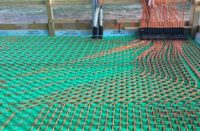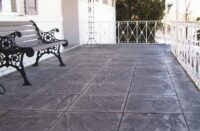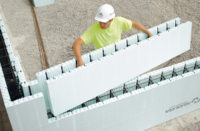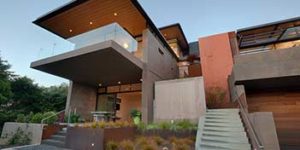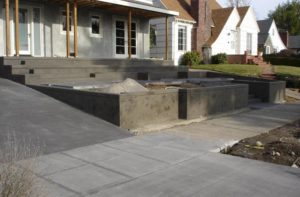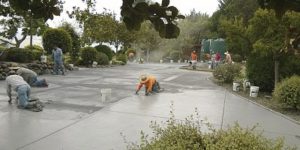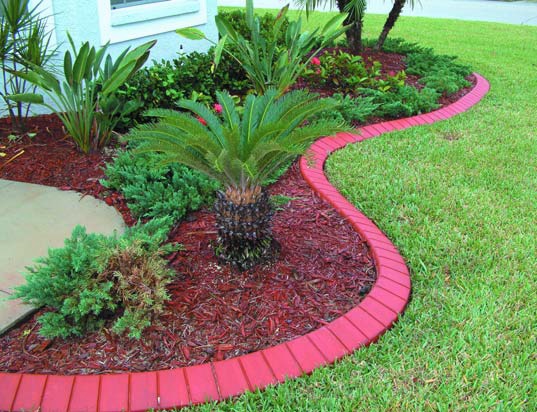 When it comes to edging that pleases the eye, decorative concrete curbs have no competition.
When it comes to edging that pleases the eye, decorative concrete curbs have no competition.
Railroad ties rot, bender board breaks and brick mortar crumbles. But decorative curbing is permanent.
“It’s something homeowners know they need in most cases for maintenance reasons,” says Larry Rose, president and CEO of manufacturer Curbmate Corp. “It costs slightly more than bender board but not much more, and it’s a one-time cost. We’re pricecompetitive with anything else.”
What’s more, the common curb can be gussied up with a multitude of decorative options, from angling and stamping to embedded lights and electric dog fencing. And that’s good news for contractors. Decorative flourishes can add dollars per square foot to what a customer will pay for curbing.
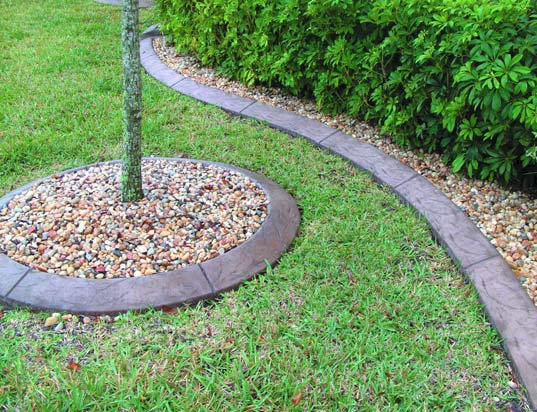 The biggest problem with decorative curbing is that, with its form setups and takedowns, the process consumes a lot of time, labor and equipment.
The biggest problem with decorative curbing is that, with its form setups and takedowns, the process consumes a lot of time, labor and equipment.
Enter the curbing machine. All the operator needs to do is keep the machine filled with fresh concrete and steer it, and it squeezes out perfectly formed curb ready to stamp and cure.
Curbing machines execute a curbing job twice or even three times as fast as traditional methods. They save in labor and trips — and, last but not least, the cost of forms.
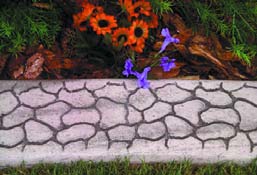 Recipe for success
Recipe for success
Any concrete job starts with the mix, and when mixing for curb machines, the experts recommend a sand to cement ratio of 3:1 or 4:1. Patrick Roach, owner of Borderline Stamp Inc., elaborates: One 47-pound bag of Type 1 or 2 portland cement, four five-gallon buckets of washed concrete sand, and two and a half to three gallons of water. At the end of the mix, he adds an Australian product that eliminates efflorescence. His recipe produces 17 to 19 feet of curb 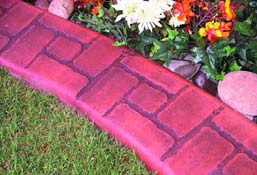 per bag of cement.
per bag of cement.
The goal is a “zero slump” mix that holds its shape. “It extrudes out the back of the machine like licorice,” Roach says. “As soon as it comes out of the machine, it actually starts to look dry.”
The water needed in the mix varies depending on the moisture in the sand, says Rose. He trains contractors to measure moisture by hand with a “snowball pack.” Wad a handful of sand and toss 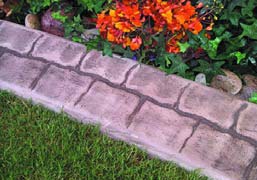 it gently in the palm, he says. If it stays together, it’s got about the right amount of moisture. Too wet, and water will seep out as it’s squeezed; too dry and it crumbles.
it gently in the palm, he says. If it stays together, it’s got about the right amount of moisture. Too wet, and water will seep out as it’s squeezed; too dry and it crumbles.
Some experts recommend spiking the mix with glass-fiber mesh for crack resistance and structural support. A fingertip’s worth of half-inch mesh will add all the extra strength a curb batch needs, Roach says. “You don’t need a lot of it in there.”
But others say glass fiber is not necessary. “I used it for years 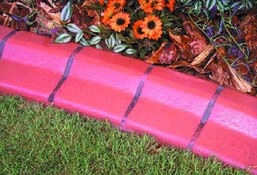 and I no longer use it,” Rose says. If the concrete has the proper amount of moisture, it will hold its own without fiber, he says. “It doesn’t hurt it. It’s just that in my opinion it doesn’t do any good.”
and I no longer use it,” Rose says. If the concrete has the proper amount of moisture, it will hold its own without fiber, he says. “It doesn’t hurt it. It’s just that in my opinion it doesn’t do any good.”
Duane Patterson, sales and marketing manager for TEAM Inc., which manufactures Curb King machines, says there is a delicate balance to achieve with glass fibers. A handful of half-inch fibers in a batch will work great, he says. But the concrete 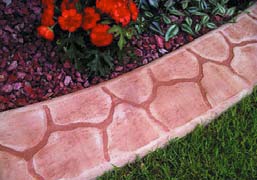 will be weaker in places where fiber clumps. “Use too much and you have a hairy curb, and you have to go back with a blowtorch and melt it,” he says.
will be weaker in places where fiber clumps. “Use too much and you have a hairy curb, and you have to go back with a blowtorch and melt it,” he says.
Another popular additive is 3⁄8 inch pea gravel, which raises the strength of the curb from 2,000 psi to more than 3,000 psi, Roach says.
Finally, control joints are cut in the curb to control cracking. “If you know how to run the machine you shouldn’t have cracking,” Roach asserts.
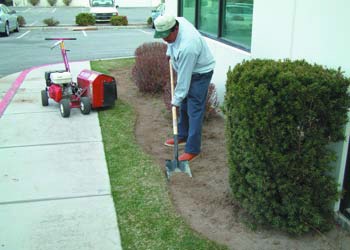 Tools and trenches
Tools and trenches
Where can you lay curbing? Anywhere, say the experts. But preparation is part of the job. “Every step you do makes your curb one step better,” Patterson says. “You need to get it to be where there’s not much adjustment needed when operating the machine.”
Prep work for curbing is simple, according to Jimmie Rojas, research and development manager for The Concrete Edge Co., manufacturers of Lil’ Bubba curb 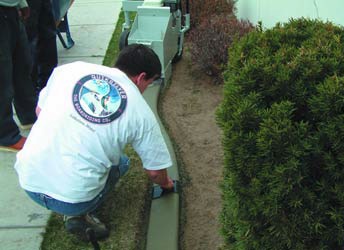 machines. Cut a trench that measures 2 inches by 9 inches, with a depth of 1 inch to 2 inches. “It should be wide enough so the curbing machine fits and runs with ease,” he says.
machines. Cut a trench that measures 2 inches by 9 inches, with a depth of 1 inch to 2 inches. “It should be wide enough so the curbing machine fits and runs with ease,” he says.
The installer packs the dirt and prepares subgrade as needed. “The trench doesn’t need to be level to the horizon,” says Rose of Curbmate. “The machine will follow it. But you don’t want it to go up and down a lot.”
There are two kinds of tools used to prepare a trench for 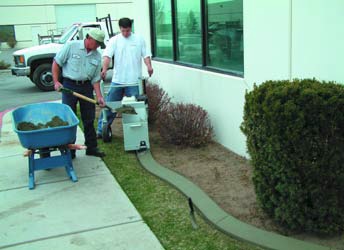 a curb machine: a sod-cutter or square shovel, which cuts the grass mat, and a trencher, which breaks up rocks, mulches root systems and stirs up the dirt.
a curb machine: a sod-cutter or square shovel, which cuts the grass mat, and a trencher, which breaks up rocks, mulches root systems and stirs up the dirt.
Roach, of Borderline Stamp, recommends the former. “You simply cut through and level as best you can,” he says. “You generally follow the lay of the land.”
Bob Leighton, consultant with Kwik Kerb USA Inc., says a trencher may not leave the dirt compact enough for successful curbing. Rocks can be kicked out and roots 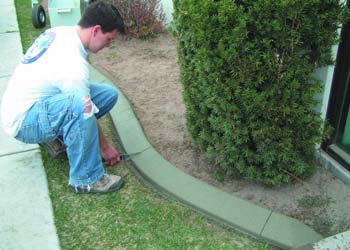 chopped, but settling dirt will weaken the curb, he says.
chopped, but settling dirt will weaken the curb, he says.
But Patterson of TEAM Inc. prefers the trencher. “It gives you a nice solid base,” he says.
There are also two kinds of curbing machines: a compaction ram machine, which pounds out the concrete, and an auger machine. The augur design is preferred for machines on big commercial jobs, Rose says, but on a residential job, a compaction ram will fill in smaller divots and is easier to keep level.
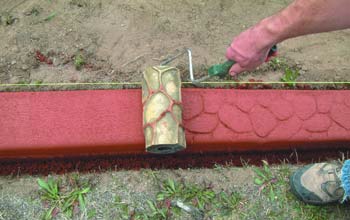 Patterson, for his part, favors a twin augur system when dealing with divots. “Rams just don’t have the climbing ability,” he says. “The ram will only put pressure on a forward stroke.”
Patterson, for his part, favors a twin augur system when dealing with divots. “Rams just don’t have the climbing ability,” he says. “The ram will only put pressure on a forward stroke.”
The machine comes with levels. A string line to one side will help the operator steer it in a straight line. “You can follow a string line with the machine but the grade of the landscape really depicts how straight the line will be,” Rojas says.
The operator has time to adjust the freshly laid curb after it’s placed but before it sets, Leighton notes.
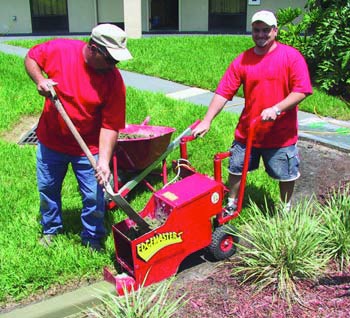 Curbing machines are usually capable of performing radiuses as tight as 14 inches, but the tighter the radius, the weaker the curb. Most advisors recommend a minimum of 30 inches to 35 inches.
Curbing machines are usually capable of performing radiuses as tight as 14 inches, but the tighter the radius, the weaker the curb. Most advisors recommend a minimum of 30 inches to 35 inches.
Shapes and patterns
Not surprisingly, today’s curbing contractor has a wealth of colors, angles, profiles and stamping patterns to choose from.
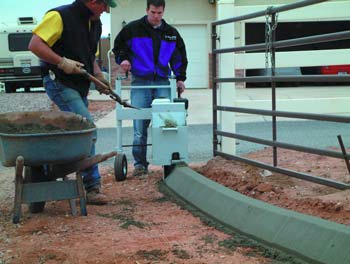 There’s mower strip curb, car park curb and slant edge curb. The most popular, Roach says, is angled curb, which gives passersby a nice view of the curb and is easy on lawnmowers. “The big movement in landscape curbing is going to stamped curbs and lighted curbs,” he says. “You’re able to do both with angled curbing.”
There’s mower strip curb, car park curb and slant edge curb. The most popular, Roach says, is angled curb, which gives passersby a nice view of the curb and is easy on lawnmowers. “The big movement in landscape curbing is going to stamped curbs and lighted curbs,” he says. “You’re able to do both with angled curbing.”
There are patterns that simulate brick, slate, cobblestone and flagstone. Borderline Stamp offers “Cactus, “Driftwood,” “Outback Textured,” “Texas Star,” “Basket Weave” and “Native Dancer,” among others.
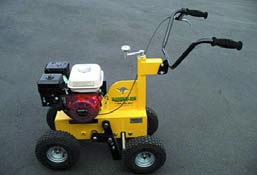 “You can pretty much match up to any existing building, driveway, whatever,” Leighton says.
“You can pretty much match up to any existing building, driveway, whatever,” Leighton says.
The national appetite for landscape curbing began to grow after the 2000 Winter Olympics in Utah, says Patterson of TEAM Inc., but the application had been commonplace in Utah for a decade and a half before that. “Nobody here thinks of doing anything else.”
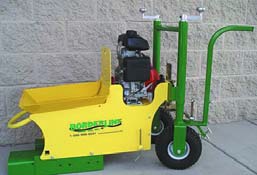 Curbing machines first caught on in the West, Roach says. Now they’re big in Texas, and they’re starting to get big on the East Coast. “Slowly but surely they’re sweeping across the country,” he says. “In certain sections of the country people haven’t even heard of [landscape] curbing yet. All we do is go in and introduce it and that’s all it takes.”
Curbing machines first caught on in the West, Roach says. Now they’re big in Texas, and they’re starting to get big on the East Coast. “Slowly but surely they’re sweeping across the country,” he says. “In certain sections of the country people haven’t even heard of [landscape] curbing yet. All we do is go in and introduce it and that’s all it takes.”
With cross-regional appeal comes region-specific problems. In Utah, for example, the ground freezes and thaws regularly, causing cracks. Patterson says the simplest and cheapest solution is to add a teaspoon of dish soap to the mix to promote air entrainment. In California, contractors tend to cut joints four feet apart, but in colder climes, contractors may carve every two and a half feet, he says.
In Florida, contractors worry more about sinkage than expansion, says Bob Leighton of Kwik Kerb. He recommends cutting joints every three or four feet in warm climes, giving the curbs some flexibility when the ground shifts below them.
